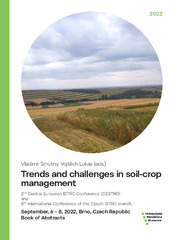Приказ основних података о документу
Conservation tillage systems could increase maize resilience to climate change
| dc.creator | Simić, Milena | |
| dc.creator | Dragičević, Vesna | |
| dc.creator | Brankov, Milan | |
| dc.creator | Dolijanović, Željko | |
| dc.creator | Kresović, Branka | |
| dc.creator | Tolimir, Miodrag | |
| dc.date.accessioned | 2023-12-15T12:16:21Z | |
| dc.date.available | 2023-12-15T12:16:21Z | |
| dc.date.issued | 2022 | |
| dc.identifier.isbn | 978-80-7509-847-4 | |
| dc.identifier.uri | http://aspace.agrif.bg.ac.rs/handle/123456789/6599 | |
| dc.description.abstract | Climate changes severely affect agricultural production, particularly dry farming. Even crops that are relatively tolerant to drought, like maize, have been recently influenced by meteorological extremes, thus significantly reducing yield potential. The adjustment of cropping technology in which soil tillage system is an essential maize growing practice is the only way for stable maize cultivation. The objective of the study was to monitor and understand how different tillage systems and fertilizer rates influence grain yield of maize grown in dry farming conditions. The study was initiated in 1978 in Zemun Polje, Belgrade, Serbia, on the chernozem soil type, while the results from 2011-2021 period are analysed. Maize hybrid ZP SC 606 has been sown at the middle of April every year. The experiment was set as a split-split-plot block design with four replications. The main treatments were three tillage systems: NT - no-till, RT – reduced, and CT - conventional tillage. In the no-tillage treatment, maize seeds were sown in the upper soil layer of 5-7 cm, directly by a special planter. In the reduced tillage treatment, soil tillage was performed in the depth of 8-10 cm, with a rotovator in autumn, while sowing is conducted in the spring after seedbed preparation (10-12 cm) with a conventional drill. The conventional tillage treatment consisted in shallow ploughing, immediately after wheat harvest in the depth of 10-15 cm, primary tillage (ploughing) in the depth of 25-30 cm in autumn and seedbed preparation (10-12 cm) inspring. The fertilizer treatments, as subplots, included control (Ø) - without fertilization, incorporation of 50kg/ha N, 50 kg/ha P and 50 kg/ha K in the autumn and supplemental N addition up to the 180 kg/ha N (F1) and240 kg/ha N (F2) before sowing in the spring. Variations in meteorological conditions of the season caused highvariability in maize grain yield. The lowest grain yield, in average, was achieved in 2021 (3.38 t/ha) and thehighest in 2014 (11.33 t/ha). Among tillage practices, higher average yield was achieved with CT (9.38 t/ha)while lower values were in NT (6.14 t/ha). In dry seasons and seasons with extreme variations (2012, 2017 and2021), stable and even higher yields were achieved in RT and NT. Thus, in 2021 the highest yield was achievedin NT (to 2.34 t/ha concerning CT). Increased fertilizer rates resulted in yield increase, from 6.59 t/ha in Ø to8.35 t/ha in F2. The differences in grain yield between fertilizer rates were higher in RT. Correlation analysisindicated that with tillage intensification (CT), yield potential is highly negatively dependent on temperature,particularly during grain filing (correlation coefficient 0.8) and high and positive with precipitation amount(correlation coefficient > 0.7), while this dependence was reduced, especially in NT (correlation coefficients <0.5). Irrespective that CT contributed to the higher grain yield in average, less intensive tillage systems enabledyield stability in drier and extreme seasons. It was noticeable that increased fertilizer rates were required inreduced systems, such as NT and particularly RT. | sr |
| dc.language.iso | en | sr |
| dc.publisher | Mendel University in Brno, Zemědělská 1, 613 00 Brno, Czech Republic | sr |
| dc.relation | info:eu-repo/grantAgreement/MESTD/Technological Development (TD or TR)/31037/RS// | sr |
| dc.rights | openAccess | sr |
| dc.rights.uri | https://creativecommons.org/licenses/by-nc-nd/4.0/ | |
| dc.source | 2nd Central European ISTRO Conference Brno, Czech Republic | sr |
| dc.subject | reduced tillage | sr |
| dc.subject | direct sowing | sr |
| dc.subject | fertilization | sr |
| dc.subject | maize | sr |
| dc.subject | productivity | sr |
| dc.title | Conservation tillage systems could increase maize resilience to climate change | sr |
| dc.type | conferenceObject | sr |
| dc.rights.license | BY-NC-ND | sr |
| dc.citation.spage | 73 | |
| dc.identifier.fulltext | http://aspace.agrif.bg.ac.rs/bitstream/id/25157/Book_of_abstracts_CESTRO_2022_Brno.pdf | |
| dc.identifier.rcub | https://hdl.handle.net/21.15107/rcub_agrospace_6599 | |
| dc.type.version | publishedVersion | sr |


